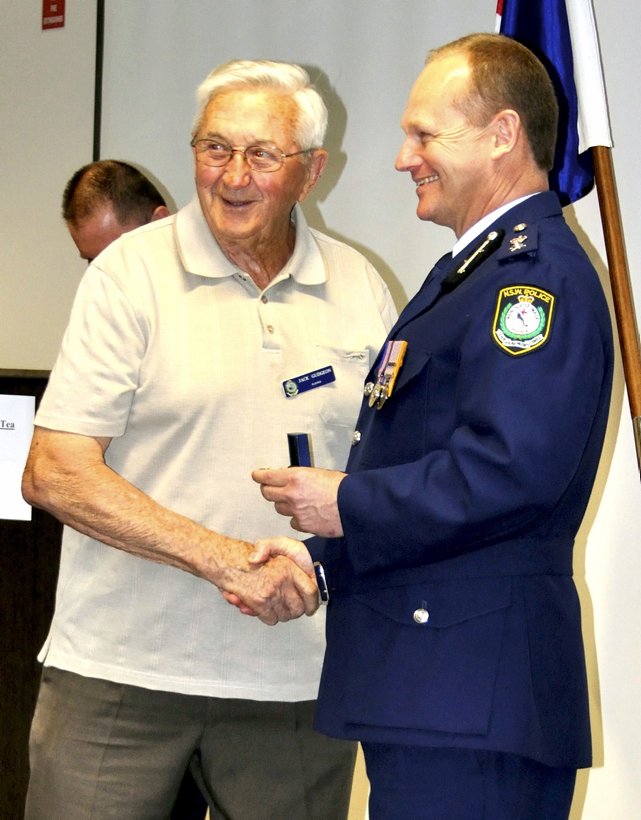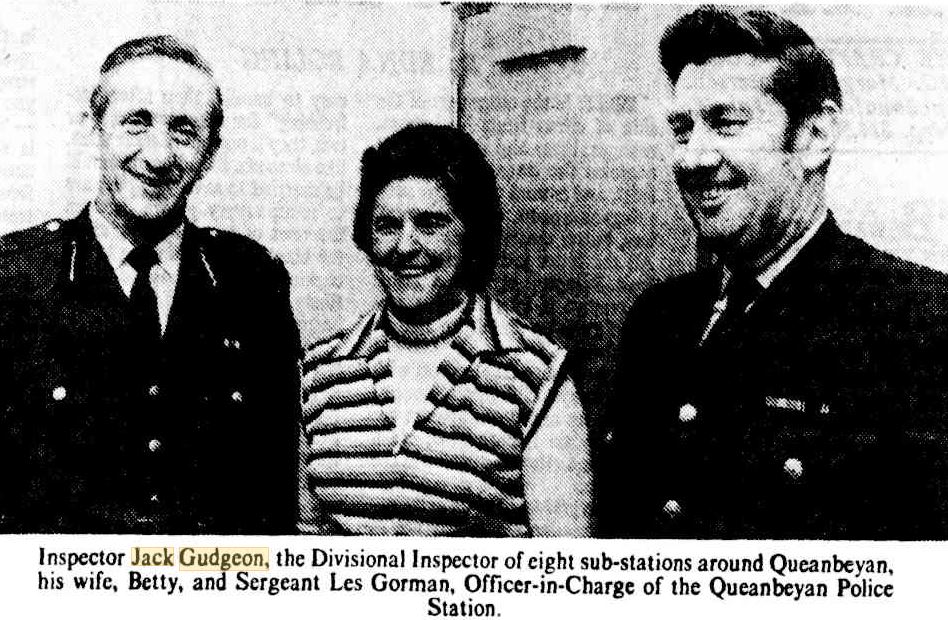John Melville GUDGEON
John Melville GUDGEON
AKA Jack
Late of Kiama
NSW Police Cadet # 497
New South Wales Police Force
[alert_yellow]Regd. # 5528[/alert_yellow]
Rank: NSW Police Cadet – commenced 17 January 1945
Probationary Constable – appointed 17 March 1947
Sergeant 3rd Class – appointed 16 July 1962
Sergeant 2nd Class – appointed 9 October 1968
Inspector 3rd Class – appointed 30 September 1977
Inspector – appointed 14 April 1978
Detective Chief Superintendent –
Final Rank = Detective Chief Superintendent
Stations: ?, South Coast District, Camden ( Cst 1950 ), Kangaroo Valley, Kiama, Queanbeyan ( O.I.C. ) 1978, TRG, Dubbo District – Retirement
Service: From 17 January 1945 to ? August 1986= 41+ years Service
Awards: National Medal – granted 29 June 1984 ( Supt )
Born: 26 March 1927
Died on: Monday 15 October 2018
Age: 91
Cause: ?
Event location: ?
Event date: ?
Funeral date: Wednesday 17 October 2018 ( Private funeral )
Funeral location: Kiama ?
Wake location: ?
Funeral Parlour: Stan Crapp, Kiama. 42322371
Buried at: ?TBA
Memorial located at: ?
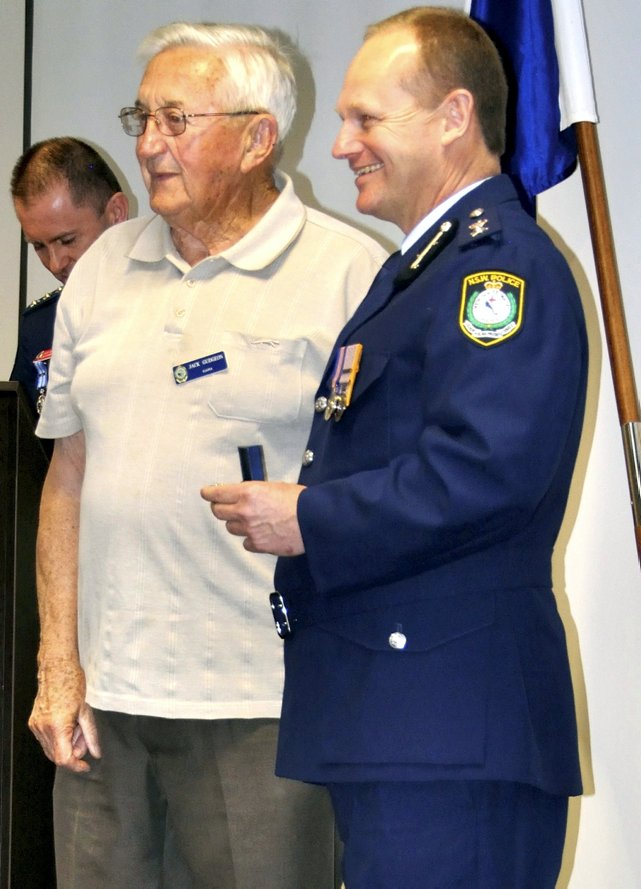
THE INAUGURAL RETIRED POLICE PIN CEREMONY AT OAK FLATS ( WARILLA ) ( LAKE ILLAWARRA ) POLICE STATION.
RETIRED POLICE RECEIVING THEIR PINS AS A MARK OF RESPECT FOR THE COMMITMENT TO POLICING SERVICE TO THE COMMUNITY OF NSW. John Melville GUDGEON with Supt. Wayne Starling
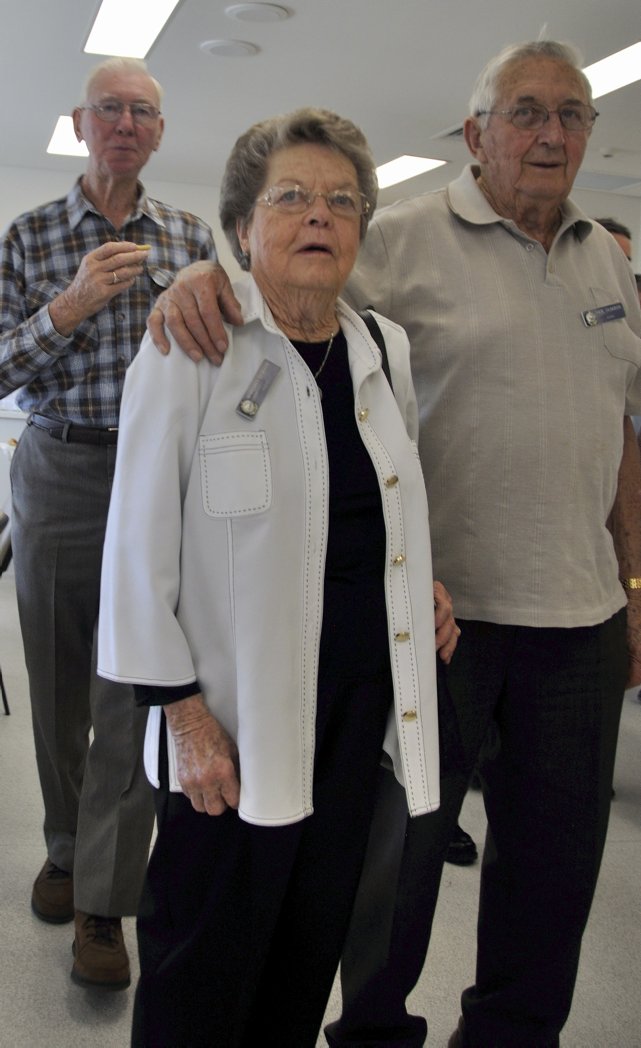
LAKE ILLAWARRA POLICE STATION, OAK FLATS.
RETIRED POLICE DAY ( 2nd YEAR )
John Melville GUDGEON with his wife Margaret.
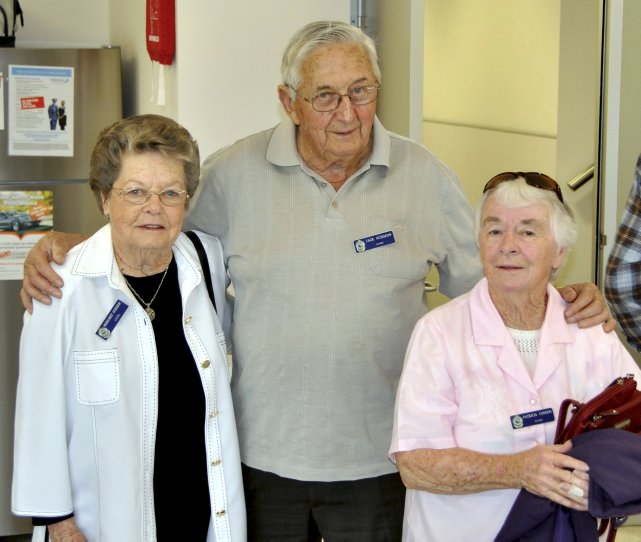
LAKE ILLAWARRA POLICE STATION, OAK FLATS.
RETIRED POLICE DAY ( 2nd YEAR )
John Melville GUDGEON with his wife, Margaret and Pat CONDON – wife of Gab ( R.I.P. )
[alert_blue]JACK is NOT mentioned on the Police Wall of Remembrance[/alert_blue] * NOT JOB RELATED
[divider_dotted]
Funeral location: TBA
[divider_dotted]
FURTHER INFORMATION IS NEEDED ABOUT THIS PERSON, THEIR LIFE, THEIR CAREER AND THEIR DEATH.
PLEASE SEND PHOTOS AND INFORMATION TO Cal
[divider_dotted]
May they forever Rest In Peace
[divider_dotted]
of Kiama
Passed away peacefully October 15 2018. Much loved husband of Betty (dec. 1989), father and father in law of Ross and Mary, Vicki Butler (dec), and his wife Margaret.
Aged 91 Years
Will be sadly missed
A private funeral service
has been held today

Published in The Sydney Morning Herald on Oct. 17, 2018
Canberra Times (ACT : 1926 – 1995), Monday 12 April 1982, page 1
New police policy succeeds at Bathurst race meeting
BATHURST: A deliberate policy by police of non-intervention had defused a “potentially explosive confrontation” with about 2,000 motor-cyclists at Mount Panorama, near Bathurst, police said yesterday.
Despite five hours of wild scenes in the camping site in front of the police station compound on Saturday night, there were no arrests.
Police described the situation on Saturday night as “at times potentially explosive.”
They said there could “have been a repetition of last year’s siege of the camping-site police station, which resulted in 64 policemen being injured by flying stones, bottles and cans.
But last night, as the crowd of more than 24,000 began heading home after the weekend motor-cycle race meeting, police said they had made only 40 arrests over the weekend, most for drink-driving.
Two people had been arrested on assault charges, one after a stabbing on Friday and another for throwing a spear late on Saturday night. There also were a number of minor drug offences.
Last year 179 people were taken into custody and the future of the race meetings threatened by the wild behaviour of troublemakers in the camping area.
Superintendent Jack Broomfield ( # 5219 ), the officer-in-charge of the 290 police officers on duty at the weekend, was “extremely happy” yesterday.
Superintendent Broomfield, who told his men to mingle with the crowd as things looked like getting out of hand on Saturday, praised his men for displaying “extreme patience and tolerance”.
Their patience was stretched to its limits after a member of the 86-strong tactical response group — the specially trained so-called riot squad — was knocked unconscious when a beer can filled with gravel hit him in the face.
Superintendent Ted Lloyd ( possibly # 5385 ), the officer-in-charge of the tactical response group, described the situation at times on Saturday as “volatile and explosive”.
He offered thanks to members of the NSW Motor Cycle Riders Association who had appealed to the crowd to remain calm and disperse.
“We gave what I would describe as some desperate-looking characters access to the police loud-hailer when things looked like getting rough, and they did a top job urging the crowd to stay calm using the kind of language motor-cyclists could relate to,” he said.
Senior-Inspector Jack Gudgeon, the operations commander of the tactical response group, said the police had had a plan this year of deliberately not getting involved in the “fun” of the bike groups.
Canberra Times (ACT : 1926 – 1995), Sunday 24 August 1980, page 14
Policemen have a night out
It was a night of rejuvenation for most of the crowd at the sixth annual Queanbeyan Police Ball on Friday. The evening certainly proved that 50-50 music was by no means ready to bow out or take a back seat to the raucous disco sounds.
A success from the start were the Marksman who provided the lively music for the occasion which also saw a couple of birthdays being celebrated, one of which was a 21st, and a wedding anniversary.
Among the 300 people at the Queanbeyan RSL Club were Superintendent Reg Martin and his wife, Dorothy, of Goulburn, the Member for Monaro, Mr John Akister, the Member for Eden Monaro, Mr Murray Sainsbury, the officer in charge of the Queanbeyan Police Station, Inspector Jack Gudgeon, and his wife, Betty, Ron and Kerry Reuban, of Jinderbyne, Pat and Dawn Robbie, of Narrabundah, and from Queanbeyan itself there were Joe Harding, who is soon off to Sydney on posting, Steven and Margaret Hadfield, Des and Margaret Lennard, and Ralph and Carolyn Parry.
Canberra Times (ACT : 1926 – 1995), Sunday 30 July 1978, page 17
It will be a gala occasion tomorrow when the Premier of NSW, Mr Wran, officially opens the new police station and courthouse in Queanbeyan.
The two buildings, costing $4 million, took 2½ years to complete.
The opening ceremony will be performed at 4pm in the foyer of the courthouse and about 400 people are expected to attend.
After the ceremony, the guests will move to the Queanbeyan Leagues Club for afternoon tea.
Among the dignitaries who will attend the function with their wives will be the NSW Attorney-General, Mr Walker, the NSW Police Commissioner, Mr Woods, and Deputy Commissioner, Mr Lees, a previous Queanbeyan police inspector, Mr Percy Hale, and the Superintendent in charge of country districts, Mr Alec Birnie.
In the evening, there will be a dinner at which the public will have an opportunity to meet members of the NSW Cabinet which will be in town for a meeting on Tuesday.
Forty policemen, including the policewoman, are now working in the comfort and luxury offered by the new station which is a far cry from the previous surroundings. The NSW Police Commissioner is considering an application to increase the number of general duties and traffic police.
The new station has elaborate safety measures. These include sensitive alarm systems, a closed circuit TV which keeps constant watch on the backyard and an internal public-address system.
The courthouse is another modern building and comprises a district court and a court of petty sessions.
Inspector Jack Gudgeon, the Divisional Inspector of eight sub-stations around Queanbeyan, his wife, Betty, and Sergeant Les Gorman, Officer-in-Charge of the Queanbeyan Police Station.
Canberra Times (ACT : 1926 – 1995), Monday 27 February 1978, page 1
MICHELAGO FIND
Inquiry to visit drug plantation
By PETER QUIDDINGTON
The NSW Government’s Royal Commission into Drug Trafficking is expected to arrive in Canberra this morning to visit the multi-million dollar marijuana plantation discovered by ACT Police at Michelago on Friday.
The commission, headed by Mr Justice Woodward, was set up after the disappearance of Griffith anti drug campaigner, Mr Don Mackay, last July.
On Saturday NSW detectives involved with inquiries into the plantation near Michelago travelled to Griffith and returned with a 43 year-old man whom they later charged with the possession of marijuana. Police took the man to the site of the crop and have alleged he is the owner.
He will appear in Queanbeyan Court of Petty Sessions this morning.
The officer in charge of Queanbeyan police, Inspector John Gudgeon, said yesterday that inquiries were still being carried out to find three men seen running from the plantation when a helicopter with ACT policemen aboard arrived there on Friday morning.
Police found a four-wheel drive vehicle at the site and traced its registered owner to an address in Canberra. However, he explained that he had sold the vehicle, along with a block of land near Michelago, to a man in the middle of last year.
Police also found a bulldozer on the site, extensive farming equipment, sheds and a piped irrigation system coming from a dam.
The crop, which was discovered behind steep hills and in thick bushland about 10 kilometres south-east of Michelago, is valued between $3 and $5 million on the open market.
The high value for a crop of this size results from the scarcity of the drug because of recent hauls in various parts of NSW.
The raid on the plantation took place after information had been given to ACT Police of marijuana being grown in the area, but senior officers said last night the source of this could not be revealed.
An RAAF helicopter carried out a search of a 14-kilometre radius around Michelago and came across the crop.
Members of the ACT drug squad took samples and later informed the NSW authorities.
Police and detectives from major centres surrounding Canberra converged on the plantation in four wheel-drive vehicles and, with the assistance of a resident, found the area.
The three men who apparently had been tending the crop had disappeared. Some of the raiding officers suggested this had been because of bungling by ACT Police, who are not responsible for the area.
However, ACT Police sources explained yesterday that, when the raid had been initiated it was believed that the plantation was on the ACT side of the border. A helicopter was the only practical means of finding the crop in such an extensive and rugged area.
The police conducting the investigation said they were not searching for the three men who had escaped, as it was expected they would have to come from the bush at some stage.
Tight security arrangements were being maintained yesterday around the farm, which is serviced by a dirt road that runs between Michelago and Gingera.
Newsmen were still not allowed near the site yesterday. Inspector Gudgeon said the reasons for this would become apparent early today.
Members of the Press would be able to look at the crop after 11 this morning. Plans were being made to have it destroyed.
Some of the plants are believed to be up to 2 metres high. Some had been harvested.
Canberra Times (ACT : 1926 – 1995), Wednesday 14 December 1977, page 3
Queanbeyan’s illegal casino closes
Queanbeyan’s illegal gambling casino vanished last week after a crackdown on casinos by Sydney police early in the week and a sudden change of policy by the NSW Government.
The Queanbeyan casino, which had a peep-hole and a bell, was housed above a pizza parlour and next door to a butcher’s shop on Monaro Street. It used to have a clientele of 30 to 40 gamblers a night.
A nearby shopkeeper said yesterday that when he opened his premises at 8am he usually saw a dozen or more men leaving the illegal club. Last week he saw no men leave the plain-fronted club door in the alleyway next to his shop.
Inspector Jack Gudgeon, the new inspector in charge of police in Queanbeyan division, said yesterday that the club ceased operating about last Wednesday after the NSW Government policy change and a raid on Sydney’s well-known Forbes Club, which led to the arrest of 15 women and six operators.
Under the Gaming and Betting Act, patrons, casino owners and employees are liable to fines up to S200 or three months’ jail.
The Act allows the clubs to be closed by raiding them and arresting patrons and operators or by making application to the Supreme Court to have them declared illegal gaming houses.
Canberra Times (ACT : 1926 – 1995), Tuesday 1 November 1977, page 3
Queanbeyan policeman retires
The officer-in-charge of the Queanbeyan police division, Detective Inspector Percy Hale, retires today after 32 years in the NSW Police Force.
Inspector Hale, who has been stationed at Queanbeyan for the past 3½ years, will be replaced by Detective-Inspector Jack Gudgeon.
A farewell for Inspector Hale, attended by the ACT Police Commissioner, Mr Reg Kennedy, was held at the Queanbeyan Leagues Club last night.
Canberra Times (ACT : 1926 – 1995), Wednesday 5 March 1969, page 3
Wife on murder charge denies argument
BOMBALA, Tuesday. — A woman charged with murder had left the Bombala RSL Club hand-in hand with her husband shortly before he was axed to death, Bombala Petty Sessions was told today.
Alfred Thomas Allen, assistant manager of the club, said the couple had paused to wave to him and other friends as they left at 2am on December 1. 1968.
Elizabeth Anne Thompson, 24, was charged today before Mr D. G. Hughes, SM, with having murdered James William Thompson, 27, plant operator, at their home in Wellington Street, Bombala, on December 1.
Allen told the court that Mr and Mrs Thompson had gone to the club about 9pm on Saturday, November 30.
He had seen Mrs Thompson dancing several times with a man he knew as George Galarovic and with her husband.
“They left at 2am”, Allen said. “They were holding hands and in my opinion quite sober”.
Peter Ronald Muir, labourer, next-door neighbour of the Thompsons, said that about 5.15am on December 1 he had been awakened by Mrs Thompson standing at his bedroom window.
She had shouted, “Peter, come quickly! Someone has got Jimmy. Someone in the room”.
Muir said he had run outside and looked over the dividing fence. He had seen an axe on the lawn and some broken glass in the Thompsons‘ bedroom window. Mrs Thompson had had streaks of blood on her face and hands.
Muir said he had driven to call police and a doctor and when he returned he had led Mrs Thompson inside.
In the bedroom he had seen Thompson lying in the middle of the bed, half covered.
“There was a lot of blood on his face and all around him”, he said.
Later he had asked Mrs Thompson what had happened and she had said, “Someone came up to Jimmy, something came down and came down again”. I asked did she see who it was. She replied, “He was wearing blue, that’s all I remember”.
Cross-examined, Muir said he had lived next door to the Thompsons for 20 months and their marriage had seemed to be a “perfectly normal, happy one”.
Dr Annesley Crowe, of Young Street, Bombala, said he had arrived at the Thompson‘s house about 5.45am and had found Thompson still breathing.
Thompson had been taken to Bombala Hospital where an operation was performed. He had died that afternoon.
Deep wounds in forehead
The Government Medical Officer for Bombala and district, Dr R. J. MacArthur, gave the cause of death as severe lacerations to the cerebrum. There were deep wounds in Thompson‘s forehead consistent with those caused by a blow with an axe, he said.
Senior Constable Horace Gant ( # 8204 ), of Bombala, told the court that Mrs Thompson had had what appeared to be bloodstains on the left sleeve of her nightdress.
She had told him, “I was in bed with Jim when I felt something brush me and heard two thumps. I woke up and saw someone running from the room”.
Detective-Sergeant George Harvey, of Cooma, told the court that bloodstains had been found on the blade and handle of the axe on the front lawn. He had inspected the Thompsons‘ house and had found no evidence of its having been ransacked or disturbed.
Detective-Sergeant John Gudgeon, of Queanbeyan, said that Mrs Thompson had been charged after an interview at the Bombala police station at which her solicitor was present. She had declined, on advice, to answer many of the questions asked.
A record of the interview was submitted to the magistrate.
In it Mrs Thompson denied that she and her husband had had an argument or disagreement.
Mrs Thompson is represented by Mr C. B. Cullen, public defender, instructed by Mr C. Werry: Sergeant D. W. Millard ( # 5969 ) is prosecuting.
The hearing will continue tomorrow.
As a detective senior constable in 1957, Barney was involved in the investigation into the bombing murder of Constable Kenneth Desmond Coussens at Bega on the 29 July, 1957.
Kenneth and Elizabeth Coussens were married in 1955.
Information provided by Constable 1st Class John Perrin of Nimmitabel, provided police with clues that led police to Myron Kelly.
When Kelly was arrested, he was also found to have an unlicensed pistol in his possession.
Kiama Independent (NSW : 1947 – 1954), Saturday 16 October 1954, page 5
TENNIS NEWS (By “ACE”)
We welcome to our Club two new members Constable Jack Gudgeon, formerly of Kangaroo Valley, and Mr. Mills, formerly of Milton, who is attached to our school staff. I believe they both wield a good racquet.
Daily Telegraph (Sydney, NSW : 1931 – 1954), Monday 12 April 1954, page 8
….. Kangaroo Valley……
Long before the white man came aborigines inhabited the Valley in thousands because of the great numbers of kangaroos which grazed there.
In the late 1790s several exploration parties, including the Hume Brothers, skirted Barrengarry Mountain and the Fitzroy Falls (on the Moss Vale side) and discovered the Valley.
Then came the “gentlemen” pioneers, notably James Osborne, for whom the Government sliced off the richest parts of the Valley. For many years the settlement was known as “Osborne Village.”
Later came the “free” settlers who initiated the dairying industry. One character who settled on one of the Valley’s lower plateaus was so carried away by the beauty of his property that he called it “The Promised Land.”
When the first pub, the Pioneer, opened in 1875 one South Coast journal reported “fights were more frequent than prayer meetings.”
But nowadays, the Valley is so crime free that the local constable, Jack Gudgeon, finds time to help farmers harvest their corn crops.
And there’s no poverty in the Valley today. Healthy cows, rich pastures, lack of floods, and high milk prices keep even the smallest dairyman well stacked.
SOME men in the past made small fortunes out of the cedar forests which dotted the Valley. Even today one Valleyite has a complete bedroom suite …….
Camden News (NSW : 1895 – 1954), Thursday 27 July 1950, page 2
CORONER’S INQUIRY.
DEATH OF THOMAS RUSSELL.
At a coroner’s Court, Court House, Camden, the District Coroner, Mr. K. S. Kelloway, found that Thomas Edward Alfred Russell died from the effect of a deadly poison known as carbon bisulphide wilfully administered by himself on the 5th June, 1950, at Camden.
THE EVIDENCE.
Dr. Crookston stated on the 6th June, 1950, at 4.15 p.m. I made a post-mortem examination of the body of Thomas Russell, aged about 36 years, at the Morgue of the Camden District Hospital.
Sergt. Marshall and Constable Slattery, of Camden Police, were present.
I was at the Hospital when this man was admitted on the night of the 5th June, 1950, and was informed that he had ”taken an overdose of something. ” I saw Dr. Jefferis washing out his stomach. There was a very strong smell of carbon bisulphide in his breath and in the stomach contents.
He died at the hospital at about 10.30 a.m. the following day, at about 12 hours after admission. The body was that of a spare young man. There was a strong smell of carbon bisulphide in the internal organs. Liver section smelt very strongly of this substance. The stomach and a section of the liver were placed in charge of the Police for poison analysis.
As there had been a statement made that the man had had a head wound and had had a plate inserted, a search of the skull was made. I found no evidence of scarring or presence of a plate. The organs appeared otherwise healthy, and no cause of death other than poisoning, as presumed from the story of the case and the smell of the tissues was found, in my opinion, death had occurred about five hours previously, and was due to poisoning by carbon bisulphide.
The fatal dose of this substance is said to be about half an ounce, and, in acute cases, death takes place in a few hours.
MISS WOOD’S EVIDENCE.
Miss Bonnie Wood; I am a single girl, 22 years of age, and I reside with my parents at 10 Edward Street, Camden. I am employed as a telephonist at the Camden Postal Exchange.
About 2 years ago I met the deceased, Thomas Edward Alfred Russell, at the Aerodrome, Camden. He was working there as a chef and I was working as a waitress. We kept company for some time and became engaged in November, 1949. He was a married man and was waiting for his divorce to become absolute. He gave me a ring.
We continued our friendship. He was working in various jobs in the country and came down to see me during his days off or his holidays. I went out with Archie Chapman on a couple of occasions and deceased got to know of it. He said he would shoot me if I did not give up my association with Chapman. I agreed to give him up and we were good friends again.
He went away again and came back about the beginning of June, 1950. I broke my promise and went out again with Chapman and Tommy got to know of it. We had a talk over that and I was going to get a transfer to the G.P.O. Sydney. I had arranged to go down to see about the job. Tommy stayed at our house overnight and in the morning of the 5th June, 1950, was cooking some breakfast for me whilst I dressed. I was putting my shoes on and Tommy grabbed me by the throat. He was upset and apologised. We left good friends, and he told me he would meet me at 10 p.m, after I had finished work. I left work at 10 p.m. on the 5th June, 1950, and went on my usual way home. Tommy was waiting just near Maloney’s store and we walked together to Elizabeth Street. He asked me how I had got on about the job and how long I had been with Chapman that day. He did not believe what I told him. He grabbed my arm and said, ”If I can’t have you no one will have you. I’ll do for you then for myself.” I tried to reason with him and he said, “I’ll take poison!” He pulled something from under his coat and struck me. I tried to defend myself, but I lost consciousness. The next thing I remembered is being in hospital.
Tommy has often said to me, ‘If anything happens to you I will go too.” Deceased was about 40 years of age. He was born in England. He told me he had left a will and left everything to me. I believe he had about £700 in the bank. He said something about cyanide.
EVIDENCE OF MRS. WOOD.
Mrs. Mabel Evelyn Wood: I am a married woman and I reside with my husband and family at No. 10 Edward Street, Camden. On the 5th June, 1950, about 7 p.m. I was at home when the deceased came in. He was in good health and spirits. He stayed there until about 9.45 p.m. He then said, ”I will go now and meet Bonnie.” He left the house. He was not carrying anything when he left. He returned about 10.10 p.m. in a state of collapse. He said, ”For God’s sake go up near the Railway. I think I have killed Bonnie. I have taken poison.” My husband and daughter left the house. I got deceased to the kitchen sink and gave him several drinks of salt and water.
I phoned Doctor Jefferis and he came and treated deceased who was then taken to the Camden District Hospital. When deceased came into the house on the second occasion that night he had a very heavy smell about him.
Gwenneth May Wood: I am a single girl and I reside with my parents at 10 Edward Street, Camden. About 7 p.m. on the 5th June, 1950, I was at home with my parents. The deceased, Thomas Russell came into the kitchen. He greeted us and appeared to be in good spirits. He was not carrying anything. He talked to us until about 9.45 p;m. and then said, ”I will go and meet Bonnie.” That is my sister. She was to cease duty at 10 p.m. She was engaged to deceased.
About 10.10 p.m. the same date, deceased almost fell in at the kitchen door and sat on a chair. He said, ”For God’s sake go to the Railway Station. I think I have killed Bonnie. I have taken poison.”
We went to Mitchell Street and found Bonnie. She was in a bad condition and bleeding from the head. Deceased was taken to hospital after being treated by Dr. Jefferis.
POLICE EVIDENCE.
Const. John Melville Gudgeon, stationed at Camden: About 10.10 p.m. on the 5th June, 1950, in response to a phone call I went to Mitchell Street, Camden, where I saw Bonnie Wood. She was bleeding freely from wounds in her head. I was informed that she had been out with Thomas Russell earlier in the night.
With Sergeant Marshall I went to Mitchell Street where I saw Gwen Wood. Sergeant Marshall said to her, ”What happened?” She said, ”Tom ran into the house and said he had done something to Bonnie up near the Railway, and Dad and I came up here looking for her.” Sergt. Marshall said, ”Where is Tom Russell now.” She said, ”I think he is round with mum lying on the settee.”
We went to No. 10 Edward Street, Camden, where I saw the deceased lying on the settee. The man appeared to be dead. Sergeant Marshall said to Mrs. Wood, who was in the kitchen there, ”What happened here?” She said, ”Tom was in here talking with us till about 9.45 p.m. and then he said he was going up to meet Bonnie. He came back about ten past ten and came into the kitchen. He looked very sick. He said, ”For God’s sake go up near the railway. I think I have killed Bonnie. I have taken poison.” He then collapsed.
I rang the doctor.
Later I searched the road in Mitchell Street and found a tomahawk.
Deceased could only say, ”I got her.”
DIVORCE’S WIFE.
Mrs. Russell; My name is Glady Emily Russell. I am the divorced wife of the deceased, Thomas Edward Alfred Russell, and I reside at 64 Lucas Road, Burwood.
Deceased was born in Walsall, England, on the 16th September, 1900. He was a chef by occupation. We were married in Walsall, England, and came to this country about 27 years ago. I obtained a divorce from him. When I last saw him he had not made a will and owned no property.
On more than one occasion whilst I was living with him he threatened to shoot the children and me and then commit suicide. He has no relatives in this country.
Mr. Haddin stated: I knew the deceased, Thomas Edward Alfred Russell. I had arranged to engage him as a gardener and he started work on my property on the morning 5th June, 1950. He worked all day and left about 5 p.m. I did not see him again after that. About ? months ago I purchased some carb? bisulphide to destroy ants on my property. I used some of the poison and portion was left in a bottle in my garage. It is not there now. The deceased had access to my garage.
Detective Sergt. Haimes, of Liverpool : After midnight on the 5th June 1950, with Constable Raines, I commenced inquiries concerning the deceased, Thomas Edward Alfred Russell, who was then in the Camden District Hospital, suffering, it is believed, from the effects of poison. I endeavoured to have a conversation with him but he could not converse with me, beyond saying that he was dying of thirst.
I made numerous inquiries and was informed by a number of people that deceased had stated his intention of taking poison in an endeavour to take his life and also to others that he had taken poison. I searched the property of the deceased at his place of employment and found a note, produced. I also found a note in the handbag of Miss Wood, produced.
I made a search of the garage at “Carnarvon,” Kirkham, but could find no bottle of poison of similar description to that from which I believed the deceased died. I can find no suggestion of foul play to cause the death of deceased, but the inquiry confirms the fact that deceased took poison, from the effect of which, he subsequently died. I have been unable to trace any banking account in the name of deceased and as far as can be ascertained he left no property.
